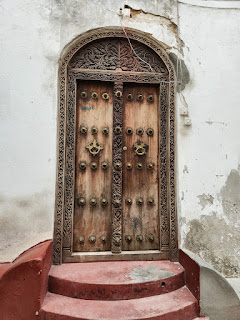We were grateful that on Feb 22 we were picked up at our hotel and taken one hour south to a resort in the south of Zanzibar. We were very happy to find that we had been booked into a villa with its own swimming pool and access to a lovely beach. We truly needed the rest! It had been a busy few days and we were looking forward to relaxing by the pool side.
The Residence (the name of the hotel) is situated in a very quiet part of the island on the Indian Ocean. The days stretch out before us and the heat is crushing by noon, so we took advantage of the pool and spent time reading and catching up on emails and...well...this blog as well.
We were cautioned, upon arrival, to keep our doors closed and to avoid leaving items on our patio as the monkey's tend to take these things.
It turns out there is a thriving colony of the endangered red colobus monkey which is found only on this Island of Unguja (the largest island in Zanzibar). It seemed that our villa was positioned on their daily foraging path and so we saw them frequently on our patio.
On our last day the monkeys simply opened our sliding door (which was on a latch) went into our living room and took a packge of dates and an apple, then went outsoide and fought over it all!
We made an attempt at the ocean, but honestly as it is quite shallow the water is so hot it is not refreshing at all. We stuck to our pool, enjoyed the peace and quiet and the beautiful sunsets and gathered our strength for the next leg of our journey. After 7 days we repacked and prepared to make the trek to Botswana for our next Safari adventure.























































